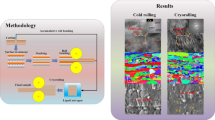Abstract
This work elucidates the effect of interface orientation, loading mode, and crystallography on the deformation mechanisms of Cu-Nb–multilayered nanocomposites. Molecular dynamics simulations of deformation behavior of accumulative roll-bonded Cu-Nb–multilayered nanocomposites (MNCs) were performed at room temperature conditions and at a constant strain rate under iso-stress and iso-strain conditions. Interface deformation mechanisms involving nucleation of partial dislocation at the interface and gliding in the Cu layer were observed under iso-stress and iso-strain conditions. Uniaxial stress–strain curves were analyzed for tension and compression under iso-stress and iso-strain loading conditions. The stress–strain plots were explored to understand the elastic, yield, and post-yielding behavior of Cu-Nb MNCs. Under compression with interface orientation normal to the loading direction, twin nucleated via gliding of partial dislocations. Under tension in the iso-stress case, only slip-assisted deformation was observed. Conversely, the deformation behavior under compression and tension was via slip and twinning, respectively, for iso-strain conditions.



Similar content being viewed by others
References
Yavas H, Fraile A, Huminiuc T, Sen HS, Frutos E, Polcar T (2019) Deformation-controlled design of metallic nanocomposites. ACS Appl Mater Interfaces 11:46296–46302. https://doi.org/10.1021/acsami.9b12235
Demkowicz MJ, Hoagland RG, Hirth JP (2008) Interface structure and radiation damage resistance in Cu-Nb multilayer nanocomposites. Phys Rev Lett 100:136102. https://doi.org/10.1103/PhysRevLett.100.136102
Carpenter JS, Zheng SJ, Zhang RF, Vogel SC, Beyerlein IJ, Mara NA (2013) Thermal stability of Cu–Nb nano lamellar composites fabricated via accumulative roll bonding. Philos Mag 93:718–735. https://doi.org/10.1080/14786435.2012.731527
Gao Y, Yang T, Xue J, Yan S, Zhou S, Wang Y, Kwok DTK, Chu PK, Zhang Y (2011) Radiation tolerance of Cu/W multilayered nanocomposites. J Nucl Mater 413:11–15. https://doi.org/10.1016/j.jnucmat.2011.03.030
Mara, Nathan Allan, Bhattacharyya, Dhriti, Dickerson, Pat, Hoagland, Richard, and Misra, Amit. Ultrahigh strength and ductility of metallic nanolayered composites. United States. https://www.osti.gov/servlets/purl/962321., (n.d.).
Wang J, Zhou Q, Shao S, Misra A (2017) Strength and plasticity of nanolaminated materials. Mater Res Lett 5:1–19. https://doi.org/10.1080/21663831.2016.1225321
Zhang RF, Germann TC, Liu X-Y, Wang J, Beyerlein IJ (2014) Layer size effect on the shock compression behavior of fcc–bcc nanolaminates. Acta Mater 79:74–83. https://doi.org/10.1016/j.actamat.2014.07.016
Li N, Wang J, Misra A, Huang JY (2012) Direct observations of confined layer slip in Cu/Nb multilayers. Microsc Microanal 18:1155–1162. https://doi.org/10.1017/S143192761200133X
Beyerlein IJ, Wang J, Zhang R (2013) Mapping dislocation nucleation behavior from bimetal interfaces. Acta Mater 61:7488–7499. https://doi.org/10.1016/j.actamat.2013.08.061
Demkowicz MJ, Hoagland RG (2008) Structure of Kurdjumov-Sachs interfaces in simulations of a copper–niobium bilayer. J Nucl Mater 372:45–52. https://doi.org/10.1016/j.jnucmat.2007.02.001
Petford-Long AK, Chiaramonti AN (2008) Transmission electron microscopy of multilayer thin films. Annu Rev Mater Res 38:559–584. https://doi.org/10.1146/annurev.matsci.38.060407.130326
Nelasov IV, Lipnitskii AG (2016) The study of Cu/Nb interface diffusion using molecular dynamics simulation, St Petersburg Polytech. Univ J Phys Math 2:91–95. https://doi.org/10.1016/j.spjpm.2016.05.004
Damadam M, Shao S, Salehinia I, Ayoub G, Zbib HM (2017) Molecular dynamics simulations of mechanical behavior in nanoscale ceramic-metallic multilayer composites. Mater Res Lett 5:306–313. https://doi.org/10.1080/21663831.2016.1275864
An Q, Yang W, Liu B, Zheng S (2020) Interface effects on the properties of Cu–Nb nanolayered composites. J Mater Res 35:2684–2700. https://doi.org/10.1557/jmr.2020.283
Rao SI, Hazzledine PM (2000) Atomistic simulations of dislocation–interface interactions in the Cu-Ni multilayer system. Philos Mag A 80:2011–2040. https://doi.org/10.1080/01418610008212148
Lee S-B, LeDonne JE, Lim SCV, Beyerlein IJ, Rollett AD (2012) The heterophase interface character distribution of physical vapor-deposited and accumulative roll-bonded Cu–Nb multilayer composites. Acta Mater 60:1747–1761. https://doi.org/10.1016/j.actamat.2011.12.007
Demkowicz MJ, Thilly L (2011) Structure, shear resistance and interaction with point defects of interfaces in Cu–Nb nanocomposites synthesized by severe plastic deformation. Acta Mater 59:7744–7756. https://doi.org/10.1016/j.actamat.2011.09.004
Mara NA, Beyerlein IJ (2014) Review: Effect of bimetal interface structure on the mechanical behavior of Cu–Nb fcc–bcc nanolayered composites. J Mater Sci 49:6497–6516. https://doi.org/10.1007/s10853-014-8342-9
Misra A, Hirth JP, Hoagland RG (2005) Length-scale-dependent deformation mechanisms in incoherent metallic multilayered composites. Acta Mater 53:4817–4824. https://doi.org/10.1016/j.actamat.2005.06.025
Plimpton S (1995) Fast parallel algorithms for short-range molecular dynamics, J Comp Phys, 117, 1–19 (n.d.).
Stukowski A (2010) Modelling Simul. Mater. Sci. Eng. 18, 015012, (n.d.).
Kang K, Wang J, Beyerlein IJ (2012) Atomic structure variations of mechanically stable fcc-bcc interfaces. J. Appl. Phys. 111, 1673., (n.d.).
Kashinath A, Demkowicz MJ (2011) A predictive interatomic potential for He in Cu and Nb. Model Simul Mater Sci Eng 19(3):035007. https://doi.org/10.1088/0965-0393/19/3/035007
Demkowicz MJ, Hoagland RG (2008) Structure of Kurdjumov–Sachs interfaces in simulations of a copper–niobium bilayer. , 372(1),45–52. https://doi.org/10.1016/j.jnucmat.2007.02.001.
Daw Murray S, Baskes MI (1984) Embedded-atom method: derivation and application to impurities, surfaces, and other defects in metals. Physical Review B, 29(12)
Plimpton S (1995) Fast parallel algorithms for short-range molecular dynamics. J Comp Phys 117:1–19
Pal-Val P, Pal-Val L, Natsik V, Davydenko A, Rybalko A (2015) Giant Young’s modulus variations in ultrafine-grained copper caused by texture changes at post-Spd heat treatment / Gigantyczne Zmiany Modułu Younga W Ultra Drobnoziarnistej Miedzi Spowodowane Przez Zmiany Tekstury W Trakcie Obróbki Cieplnej Po SPD. Arch Metall Mater 60:3073–3076. https://doi.org/10.1515/amm-2015-0491
Rohith P, Sainath G, Choudhary BK (2018) Effect of orientation and mode of loading on deformation behaviour of Cu nanowires. Comput Condens Matter 17:e00330. https://doi.org/10.1016/j.cocom.2018
Acknowledgements
The authors gratefully acknowledge the faculty startup support provided by the College of Engineering at the University of Nevada, Reno.
Author information
Authors and Affiliations
Contributions
Anugraha Thyagatur: methodology, investigation, and writing—original draft; Leslie T Mushongera: conceptualization, writing—review and editing, funding acquisition.
Corresponding author
Ethics declarations
Competing interests
The authors declare no competing interests.
Additional information
Publisher's note
Springer Nature remains neutral with regard to jurisdictional claims in published maps and institutional affiliations.
Rights and permissions
About this article
Cite this article
Thyagatur, A., Mushongera, L.T. Unraveling the effects of interface orientation and crystallography on the deformation mechanisms of accumulative roll-bonded Cu-Nb–multilayered nanocomposites using molecular dynamics. J Mol Model 28, 166 (2022). https://doi.org/10.1007/s00894-022-05155-2
Received:
Accepted:
Published:
DOI: https://doi.org/10.1007/s00894-022-05155-2




